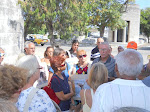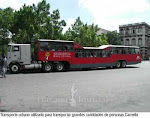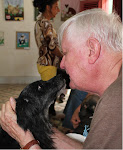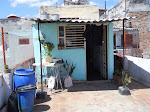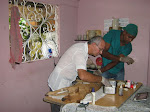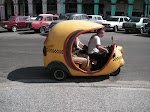Lázara's Dog
Sander, a man from Holland, took his vacation in Cuba and came to know Lázara, an older Cuban lady who lived in a makeshift home built on the rooftop of an 8 story building in Old Havana. To address housing shortages, many Cubans have built homes like this. They call them "azoteas." Lázara has a dog who reminds me lots of Aló Presidente, my favorite among the dozen animals who make Aniplant's headquarters their home. (See my blog, Aló Presidente, from 8/22/10.)
Sander felt the dog was being abused and needed help, and through our mutual friend, Nikki (see my blog, You Have to Love Nicole, from 9/17/10), we were asked to help this dog, and I translated a request to Nora Garcia to see what we could do. Sander was willing to bring the dog to Holland and keep him as his pet if that was best.
Nora, knowing there is no Cuban law against mistreating animals, decided to call on Lázara and make friends with her. Luckily, Lázara was already a fan of Nora's radio shows and recognized her when she came to her place. Nora was offering help with the dog in the form of parasite treatments, help with food supplies, etc. Sander's offer of adopting the dog was refused by Lázara, but Sander's assuming a Godfather's role to the dog was readily accepted. With a little discussion and a few emails back and forth, Lázara was happy to accept most of Sander's requests for a better life for the dog, which included:
--Nora will visit occasionally to check on him
--Nora can assist with supplies of dog food
--He will get parasite and vet medical attention as needed
--His sleeping area will be cleared of junk
--He'll get a nice pillow to sleep on
--He'll get occasional walks and a leash
As Sander said, "This dog is a sweetheart and deserves the best he can get."
All of these agreements were made except the one about walks. It is difficult for Lázara to use the 8 flights of stairs. No elevator is usual in Cuba where they work only occasionally or not at all. Dogs are less safe on the streets than in their homes. Nora agrees with eliminating the regular walks. With a little negotiation and a friendly, helpful approach, Nora accomplished lots of beneficial changes for the dog and a chance to check up on him. I think Sander is pleased with how it has worked out so far.
The dog needed help, and Sander knew it. We later learned that importing animals to the European Union is almost impossible because of chipping requirements and tough inoculation requirements. Microchips are unknown in Cuba.
There are 2 million people in Havana, and so many of them know Nora because of her radio shows teaching of humane treatment of animals. Lázara's dog is one more beneficiary of all that education work.
Les Inglis
Friday, September 30, 2011
Friday, September 23, 2011
Power Politics
Power Politics
I'm not big on political arguments, although I'm never without an opinion. On Cuba vs. US matters, I try to stay silent, but a good friend of ours, Sasha, who has a thought provoking public radio talk show called "Sound off With Sasha" in Naples, FL, told us she was going to have a show on US Cuban policy, and I was asked to phone in my comments or questions. The primary guest on the show was a former US State Department official, who did his best to describe and justify US policy towards Cuba.
Now I do want to say that despite little tweaks to travel rules for US citizens, US policy towards Cuba was set in the early 1960's and has changed little since then. Mainly it consists of an embargo (Cubans call it a blockade) on US products going to Cuba, severe restrictions on travel to Cuba, and other rules, all designed to deny the Cuban government's access to US currency and US products.
Is it successful? Well that depends upon whom you ask. Actually the Cuban government blames the embargo (el bloqueo) for nearly every problem Cuba has, so I judge they would tell you it is successful. The US government clearly thinks it is working or it would have been scrapped a long time ago. Ask the Cuban people, and they believe our embargo is the reason they must lead a life without many amenities like electronics, appliances, special foods, etc. The US man in the street probably doesn't know if it works or not as he has never been there and doesn't know anyone who has. So no wonder there isn't a popular push to end the embargo, everyone either thinks it's working or doesn't know.
What's my opinion? Well, I think it really only hurts the Cuban people by providing an excuse for not fixing anything that adversely affects them, while hardly influencing the Cuban government. Cuba can get hard currencies in other ways. For example, it has developed a thriving, profitable tourist business with most countries except the US, which has outpaced their former best exported product, sugar--as that industry has declined.
So I listened to this Washington insider on Sasha's program go on for the better part of an hour on the benefits of our Cuban policy, really feeling he was justifying the unjustifiable treatment of the Cuban people. Finally it came to be time for listener participation, and I was the second caller holding on the phone.
When my turn came, Sasha asked for my comment, and I asked, "Exactly what benefit does current US policy toward Cuba have for the American people?" I figured that ought to pin him down pretty well. But he was far slipperier than I had imagined. He said, "Well that's a rhetorical question (which it wasn't) and went on to talk about something else. In my mind, my bright question designed to put right 60 years of bad policy lingered ignored until its echoes in my head finally faded away. Mostly it was my ego that was bruised, but I got over it, and I'm still a big fan of "Sound Off With Sasha."
I learned that day that you can't easily get a politician to defend a bad policy. They're too skilled in ducking tough questions and changing the subject. I've decided, therefore, to stick to helping Cuban animals who actually suffer a little less than the Cuban people from the embargo. Maybe there's a little good in the fact that most politicians don't think much about animals.
Les Inglis
I'm not big on political arguments, although I'm never without an opinion. On Cuba vs. US matters, I try to stay silent, but a good friend of ours, Sasha, who has a thought provoking public radio talk show called "Sound off With Sasha" in Naples, FL, told us she was going to have a show on US Cuban policy, and I was asked to phone in my comments or questions. The primary guest on the show was a former US State Department official, who did his best to describe and justify US policy towards Cuba.
Now I do want to say that despite little tweaks to travel rules for US citizens, US policy towards Cuba was set in the early 1960's and has changed little since then. Mainly it consists of an embargo (Cubans call it a blockade) on US products going to Cuba, severe restrictions on travel to Cuba, and other rules, all designed to deny the Cuban government's access to US currency and US products.
Is it successful? Well that depends upon whom you ask. Actually the Cuban government blames the embargo (el bloqueo) for nearly every problem Cuba has, so I judge they would tell you it is successful. The US government clearly thinks it is working or it would have been scrapped a long time ago. Ask the Cuban people, and they believe our embargo is the reason they must lead a life without many amenities like electronics, appliances, special foods, etc. The US man in the street probably doesn't know if it works or not as he has never been there and doesn't know anyone who has. So no wonder there isn't a popular push to end the embargo, everyone either thinks it's working or doesn't know.
What's my opinion? Well, I think it really only hurts the Cuban people by providing an excuse for not fixing anything that adversely affects them, while hardly influencing the Cuban government. Cuba can get hard currencies in other ways. For example, it has developed a thriving, profitable tourist business with most countries except the US, which has outpaced their former best exported product, sugar--as that industry has declined.
So I listened to this Washington insider on Sasha's program go on for the better part of an hour on the benefits of our Cuban policy, really feeling he was justifying the unjustifiable treatment of the Cuban people. Finally it came to be time for listener participation, and I was the second caller holding on the phone.
When my turn came, Sasha asked for my comment, and I asked, "Exactly what benefit does current US policy toward Cuba have for the American people?" I figured that ought to pin him down pretty well. But he was far slipperier than I had imagined. He said, "Well that's a rhetorical question (which it wasn't) and went on to talk about something else. In my mind, my bright question designed to put right 60 years of bad policy lingered ignored until its echoes in my head finally faded away. Mostly it was my ego that was bruised, but I got over it, and I'm still a big fan of "Sound Off With Sasha."
I learned that day that you can't easily get a politician to defend a bad policy. They're too skilled in ducking tough questions and changing the subject. I've decided, therefore, to stick to helping Cuban animals who actually suffer a little less than the Cuban people from the embargo. Maybe there's a little good in the fact that most politicians don't think much about animals.
Les Inglis
Friday, September 16, 2011
Humane and Humanitarian
Humane and Humanitarian
Ask any English speaker what is a "humane" society, and you'll be told it is a group that protects animals. And so it is, but in the 1800's, humane societies focused more on orphaned children than on animals. Jeannette Ryder, the American woman who founded Cuba's Banda de Piedad in the early 1900's originally focused on both children and animals, but she came to concentrate on animals.
Today humane societies work only on animal issues as modern governments have taken over the protection of children, orphans, and families. I wondered how the dictionary reflects this evolution of meaning, and I was disappointed to learn that the Oxford English Dictionary (OED), nearly everyone's authority, doesn't even mention animals in its definition of "humane." Even dictionaries can get to be way behind the times.
The US government uses the term "humanitarian" to define an exception to the tough rules restricting travel to Cuba. They fall in nicely with the OED which says "humanitarian" means "concerned with human welfare." Well, then, how have I been able to travel five times to Cuba under a "humanitarian" exception to the rules?
Surely my work is directed at animal, not human welfare. Well, not so fast, I say. The primary effort of Cuba's Aniplant organization is massive spay-neuter campaigns. Through them we now fund the sterilization of a few thousand cats and dogs every year. This work is reducing the number of strays on the streets as unrestricted breeding diminishes. Sterilization is the only humane (in the animal welfare sense) way to reduce the number of stray animals on the streets. Well, how does sterilization further "humanitarian" goals (in the human welfare sense)?
Rabies is the answer. While it is a rare disease in advanced societies, it is carried by wild animals and can never be fully controlled. Outbreaks can occur anywhere at any time. In recent years some African and Asian cities without good rabies control programs have been shocked at how rapidly rabies can take hold and threaten many people.
The number of strays (homeless animals) on the streets outside of homes who can be bitten by a sick raccoon, fox or bat is the driving factor in the risk of a rabies outbreak. Sterilization reduces this number and therefore reduces the incidence of rabies in humans. For this reason, animal sterilization is a humanitarian endeavor. That is how I qualify to travel to Cuba.
Well, didactic discourses on words like humane and humanitarian are boring, but here's a statistic that will shock you. Every year rabies kills 50,000 people worldwide. Yes, they're in Asia and Africa for the most part, but rabies control is the concern of most governments in the world, even in some of the smallest island nations.
Unfortunately some stray animal control programs are inhumane and Cuba operates one of them. Stray animals are caught by a cadre of dogcatchers, quarantined without food for a few days, and finally poisoned with strychnine. But studies have shown that when you reduce the number of stray animals by killing them, nature soon produces more animals to take their place. But if a stray is neutered, he still occupies his niche, nature doesn't (indeed it can't) replace him, and the population declines slowly. This is the basis of all TNR (trap, neuter, release) programs.
We think massive spay-neuter programs of the type Aniplant conducts in Cuba are so superior to killing strays that it almost goes without saying. Certainly dog and cat lovers among us would prefer to see that country with a diminishing number of homeless animals as opposed to too many animals with a high incidence of sick and injured ones. As tensions ease between Cuba and the US, soon Americans will once again visit Cuba at will. We are working so that Cuba can show its visitors a country that has responsibly acted to assure animal and human health.
Les Inglis
Ask any English speaker what is a "humane" society, and you'll be told it is a group that protects animals. And so it is, but in the 1800's, humane societies focused more on orphaned children than on animals. Jeannette Ryder, the American woman who founded Cuba's Banda de Piedad in the early 1900's originally focused on both children and animals, but she came to concentrate on animals.
Today humane societies work only on animal issues as modern governments have taken over the protection of children, orphans, and families. I wondered how the dictionary reflects this evolution of meaning, and I was disappointed to learn that the Oxford English Dictionary (OED), nearly everyone's authority, doesn't even mention animals in its definition of "humane." Even dictionaries can get to be way behind the times.
The US government uses the term "humanitarian" to define an exception to the tough rules restricting travel to Cuba. They fall in nicely with the OED which says "humanitarian" means "concerned with human welfare." Well, then, how have I been able to travel five times to Cuba under a "humanitarian" exception to the rules?
Surely my work is directed at animal, not human welfare. Well, not so fast, I say. The primary effort of Cuba's Aniplant organization is massive spay-neuter campaigns. Through them we now fund the sterilization of a few thousand cats and dogs every year. This work is reducing the number of strays on the streets as unrestricted breeding diminishes. Sterilization is the only humane (in the animal welfare sense) way to reduce the number of stray animals on the streets. Well, how does sterilization further "humanitarian" goals (in the human welfare sense)?
Rabies is the answer. While it is a rare disease in advanced societies, it is carried by wild animals and can never be fully controlled. Outbreaks can occur anywhere at any time. In recent years some African and Asian cities without good rabies control programs have been shocked at how rapidly rabies can take hold and threaten many people.
The number of strays (homeless animals) on the streets outside of homes who can be bitten by a sick raccoon, fox or bat is the driving factor in the risk of a rabies outbreak. Sterilization reduces this number and therefore reduces the incidence of rabies in humans. For this reason, animal sterilization is a humanitarian endeavor. That is how I qualify to travel to Cuba.
Well, didactic discourses on words like humane and humanitarian are boring, but here's a statistic that will shock you. Every year rabies kills 50,000 people worldwide. Yes, they're in Asia and Africa for the most part, but rabies control is the concern of most governments in the world, even in some of the smallest island nations.
Unfortunately some stray animal control programs are inhumane and Cuba operates one of them. Stray animals are caught by a cadre of dogcatchers, quarantined without food for a few days, and finally poisoned with strychnine. But studies have shown that when you reduce the number of stray animals by killing them, nature soon produces more animals to take their place. But if a stray is neutered, he still occupies his niche, nature doesn't (indeed it can't) replace him, and the population declines slowly. This is the basis of all TNR (trap, neuter, release) programs.
We think massive spay-neuter programs of the type Aniplant conducts in Cuba are so superior to killing strays that it almost goes without saying. Certainly dog and cat lovers among us would prefer to see that country with a diminishing number of homeless animals as opposed to too many animals with a high incidence of sick and injured ones. As tensions ease between Cuba and the US, soon Americans will once again visit Cuba at will. We are working so that Cuba can show its visitors a country that has responsibly acted to assure animal and human health.
Les Inglis
Saturday, September 10, 2011
Bucket of Bolts
Bucket of Bolts
I got married and left my childhood home at the end of 1955. It was six months before my graduation from college, and I had saved some money to live on so I didn't have to work during that six months. My mom and dad had given me a great childhood, a fine education, and a loving send off. They couldn't have been nicer to me, and I couldn't have been more grateful to them than I was (and still am).
After Dad's long career in sales and later management, my mom and dad were comfortable and nearing retirement and my departure lifted one more financial burden from their shoulders. Now they could begin a life dedicated to their own enjoyment rather than to rearing and educating two kids.
Dad had always been interested in cars, and I caught that fever from him. He was a Chrysler fan, and the first car I can remember was a 1935 DeSoto Airflow coupe. That car was rare even in its early years, and in my adulthood after many years of old car mania and trudging through old car shows I have only seen one other example of that exact car. Because in his earlier years he had been a traveling salesman, Dad went through lots of cars, and I loved riding in every one of them. The car he had when I got married was a 1951 Chrysler. That model was the original muscle car as its 180 horsepower was much bigger than any other brand, and a horsepower race was unleashed on the American car buying public. He had had the '51 for a few years when I left home as his traveling salesman's years were behind him, so he didn't wear out cars as fast as he used to.
A few months after I moved out of my parents' home, Mom and Dad came by our house to take us out to dinner, and he was driving a brand new 1956 Chrysler sedan. I was very surprised when I saw it, and it was a far cry from the old '51 Chrysler I had expected to see. The new one was low and sort of angular looking compared with the inverted bathtub look of the old one. And it was the first in a series of Chryslers with tailfins--something that seems silly now, but as modern as tomorrow then. With a two tone blue and ivory paint job and pushbuttons in place of a gearshift lever, it was the epitome of automobiles as far as I was concerned.
Today I know the rakish lines and tailfins are just design tricks that really offered nothing to the motorist. In fact, it would be hard to find a better example of design excess than a '56 Chrysler. Still, I look twice when I see one, and memories of Dad and his cars come flooding back.
Those memories came again in 2009 in Cuba when we went out to visit Finca Vegia, Ernest Hemmingway's wonderful estate south of Havana. We were talking with Ada Rosa Alphonso Gonzales, the Hemingway Museum Director, and our conversation turned to the separate building where Ada Rosa keeps her office. It was a wooden building built as a garage and big enough for at least four cars. I recalled Hemingway had a 1947 Lincoln Continental Convertible in his earlier years in Cuba--truly a collectors' item if you're lucky enough to have one.
"But that's not all," she told me. "We just bought back from its former owners Hemingway's 1956 Chrysler Convertible." I was stunned they had found it after all the intervening years. "It needs a complete restoration, but now we have it." She told me the family that had it knew its history, and before they sold it they held out for a house and some money, which they eventually got. (Cuba's government owns the museum.)
It's a bucket of bolts now, but Ad Rosa told me I could see it. It looked like a very large pile of auto parts under a canvas tarpaulin--the work of a lifetime for a restorer. I was permitted to turn the canvas back and get a better look. There the old convertible top was down, the upholstery was in junkyard condition, but even the pushbuttons were there tickling my memory. I have pictures of this car when it was new in books about Papa Hemingway' years in Cuba. It was a dream machine then, and now it's a mechanic's pesadilla (nightmare). But I felt a connection to the old machine, and I hope I'll be back there to see it when volunteers have brought it to show condition.
We keep going back to Finca Vegia because Nora, Aniplant's President, is like a Godmother to the dogs who live there. She always brings them meds and flea treatments, and Aniplant has conducted spay-neuter clinics in the nearby neighborhoods. The dogs are our link to the Finca, but the old Chrysler stirs me up a little too.
Les Inglis
I got married and left my childhood home at the end of 1955. It was six months before my graduation from college, and I had saved some money to live on so I didn't have to work during that six months. My mom and dad had given me a great childhood, a fine education, and a loving send off. They couldn't have been nicer to me, and I couldn't have been more grateful to them than I was (and still am).
After Dad's long career in sales and later management, my mom and dad were comfortable and nearing retirement and my departure lifted one more financial burden from their shoulders. Now they could begin a life dedicated to their own enjoyment rather than to rearing and educating two kids.
Dad had always been interested in cars, and I caught that fever from him. He was a Chrysler fan, and the first car I can remember was a 1935 DeSoto Airflow coupe. That car was rare even in its early years, and in my adulthood after many years of old car mania and trudging through old car shows I have only seen one other example of that exact car. Because in his earlier years he had been a traveling salesman, Dad went through lots of cars, and I loved riding in every one of them. The car he had when I got married was a 1951 Chrysler. That model was the original muscle car as its 180 horsepower was much bigger than any other brand, and a horsepower race was unleashed on the American car buying public. He had had the '51 for a few years when I left home as his traveling salesman's years were behind him, so he didn't wear out cars as fast as he used to.
A few months after I moved out of my parents' home, Mom and Dad came by our house to take us out to dinner, and he was driving a brand new 1956 Chrysler sedan. I was very surprised when I saw it, and it was a far cry from the old '51 Chrysler I had expected to see. The new one was low and sort of angular looking compared with the inverted bathtub look of the old one. And it was the first in a series of Chryslers with tailfins--something that seems silly now, but as modern as tomorrow then. With a two tone blue and ivory paint job and pushbuttons in place of a gearshift lever, it was the epitome of automobiles as far as I was concerned.
Today I know the rakish lines and tailfins are just design tricks that really offered nothing to the motorist. In fact, it would be hard to find a better example of design excess than a '56 Chrysler. Still, I look twice when I see one, and memories of Dad and his cars come flooding back.
Those memories came again in 2009 in Cuba when we went out to visit Finca Vegia, Ernest Hemmingway's wonderful estate south of Havana. We were talking with Ada Rosa Alphonso Gonzales, the Hemingway Museum Director, and our conversation turned to the separate building where Ada Rosa keeps her office. It was a wooden building built as a garage and big enough for at least four cars. I recalled Hemingway had a 1947 Lincoln Continental Convertible in his earlier years in Cuba--truly a collectors' item if you're lucky enough to have one.
"But that's not all," she told me. "We just bought back from its former owners Hemingway's 1956 Chrysler Convertible." I was stunned they had found it after all the intervening years. "It needs a complete restoration, but now we have it." She told me the family that had it knew its history, and before they sold it they held out for a house and some money, which they eventually got. (Cuba's government owns the museum.)
It's a bucket of bolts now, but Ad Rosa told me I could see it. It looked like a very large pile of auto parts under a canvas tarpaulin--the work of a lifetime for a restorer. I was permitted to turn the canvas back and get a better look. There the old convertible top was down, the upholstery was in junkyard condition, but even the pushbuttons were there tickling my memory. I have pictures of this car when it was new in books about Papa Hemingway' years in Cuba. It was a dream machine then, and now it's a mechanic's pesadilla (nightmare). But I felt a connection to the old machine, and I hope I'll be back there to see it when volunteers have brought it to show condition.
We keep going back to Finca Vegia because Nora, Aniplant's President, is like a Godmother to the dogs who live there. She always brings them meds and flea treatments, and Aniplant has conducted spay-neuter clinics in the nearby neighborhoods. The dogs are our link to the Finca, but the old Chrysler stirs me up a little too.
Les Inglis
Subscribe to:
Posts (Atom)

